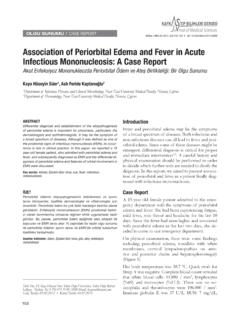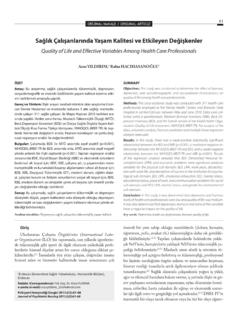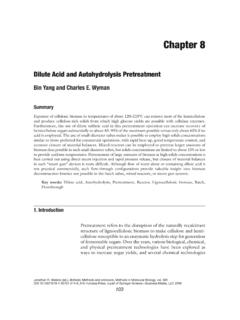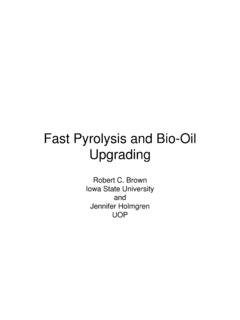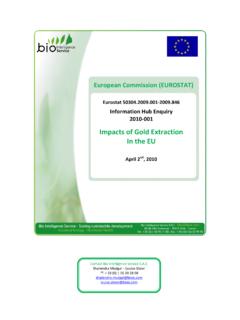Transcription of EFFECTS OF CHEMICAL MODIFICATIONS ON …
1 A. BENDAK*S. M. EL-MARSAFI*SUMMARY : A general review on polyester fibres formation is given illustrating its structure,polymerization reactions as well as CHEMICAL , physical and mechanical properties. MODIFICATIONS ofpolyester fibres are also reported. Alkalies, amines, solvents either aqueous or non-aqueous attackpolyester fibres differently. Their EFFECTS in inducing structural and properties changes are Words: polyester fibers, fibres are Man-made fibres in which theforming substance is a long chain polymer composed ofat least 85% by weight of an ester of dihydric alcohol andterephthalic acid (1). polyester fibres found immediate acceptance ineasy-care, wash-and-wear, and durable press had excellent wrinkle recovery, either wet or of polyesterThe linear homopolymer poly (ethylene-terephthalate)is the dominant composition for polyester fibres.
2 Numberaverage molecular weights of about are requiredfor useful textile-fibre properties, but lower values givestaple of low tendency to pilling, and higher values provi-de high strength fibres for industrial use (2,3).The length of the repeated unit in poly (ethyleneterephthalate) along the chain is A, a value onlyslightly less than that expected for a fully extended chainwith one CHEMICAL unit to the geometric repeating unit,and successive ester groups in the trans configuration toeach other ( A). The chains are therefore nearlyplanar. The unit cell is triclinic (4), the atomic positions inthe crystallite indicate that no special forces of attractionexist between the molecules.
3 The spacings betweenatoms of neighboring molecules is of the order expect ifVan der Waals forces operate (4).Drawn polyester fibres may be considered to becomposed of crystalline and non-crystalline regions. Thetheoretical density of pure crystalline material can bedetermined mathematically from the dimensions of the unitcell. Percentage crystallinity and molecular orientationrelate to tensile strength and shrinkage; however, thevarious methods of measurement are problematic (5).Polymerization reactionsPolyester polymer is produced commercially in a two-step polymerization process, ie, monomer formation byester interchange of dimethyl terephtalate with glycol oresterification of terephthalic acid with glycol followed bypolycondensation by removing excess glycol:* From Textile Research Division, National Research Center, Dokki,Cairo, of Islamic Academy of Sciences 4:4, 275-284, 1991 EFFECTS OF CHEMICAL MODIFICATIONSON polyester FIBRESSTEP 1: Ester interchange:Esterification:STEP 2: Polycondensation.
4 Monomer formation (STEP 1) by the catalyzed ester-interchange reaction between molten dimethyl tereph-thalate and glycol takes place at about 200 C. The prod-uct is a mixture of monomer, very low molecular weightpolymer, and as a methanol by - product, which distills at150 C. Ester-interchange catalysts are divalent salts ofmanganese, cobalt, magnesium, zinc, or calcium. Analternative monomer formation system involves tereph-thalic acid rather than dimethyl terephthalicpthalate andan uncatalyzed direct esterification rather than ester-interchange. The monomer which is the same from bothmethods expect for some end groups, usually is poly-merized (STEP 2) in the presence of an antimony cata-lyst.
5 Chain extension is promoted by removal of excessglycol from the very viscous melt at about 280 C, withcarefully controlled agitation and a progressive reductionof pressure to about 200 Pa. Heating is continued atabout 280 C until the desired degree of condensation isobtained (6).Properties of polyester fibresChemical propertiesEffect of alkalies: polyester fibres have good resist-ance to weak alkalies high temperatures. It exhibits onlymoderate resistance to strong alkalies at room tempera-ture and is degraded at elevated of acids:Weak acids, even at the boiling point,have no effect on polyester fibres unless the fibres areexposed for several days.
6 polyester fibres have goodresistance to strong acids at room temperature. Prolon-ged exposure to boiling hydrochloric acid destroys thefibres, and 96% sulfuric acid and causes disintegration ofthe of solvents: polyester fibres are generallyresistant to organic solvents. Chemicals used in cleaningand stain removal do not damage it, but hot m-cresoldestroys the fibres, and certain mixtures of phenol withtrichloromethane dissolve polyester fibres. Oxidizingagents and bleachers do not damage polyester properties: polyester fibres exhibitgood resistance to sunlight, and it also resists abrasionvery well. Soaps, synthetic detergents, and other laundryaids do not damage it.
7 One of the most serious faults withpolyester is its oleophilic quality. It absorbs oily materialseasily and holds the oil tenaciously (7).Physical propertiesMoisture regain:The moisture regain of polyester islow, ranges between to percent. Although poly-esters are non-absorbent, they do not have wicking abil-ity. In wicking, moisture can be carried on the surface ofthe fibre without absorption (8).Specific gravity: The specific gravity or on type of polyester fibres is moderate. Poly-ester fibres have a density greater than polyamide fibresand lower than rayon. Fabrics made from polyester fibresare medium in weight (8).Heat effect:The melting point of polyester is close tothat of polyamide, ranging from 250 to 300 C.
8 Polyesterfibres shrink from flame and melt, leaving a hard blackresidue. The fabric burns with a strong, pungent setting of polyester fibres, not only stabilizes sizeand shape, but also enhances wrinkle resistance of thefibres (8).Mechanical properties:A wide of polyester fibresproperties is possible depending on the method of manu-facture. Generally, as the degree of stretch is increased,which yields higher crystallinity and greater molecularorientation, so are the properties, , tensile strengthand initial Young's modulus. At the same time elongationnormally decreases. An increase in molecular weightfurther increases tensile strength, modulus and extensi-bility (9).
9 Shrinkage of the fibres also varies with the mode oftreatment. If relaxation of stress and strain in the orientedfibre occurs, shrinkage decreases but the initial modulusmay be also reduced. Yarns maintained at a fixed lengthand constant tension during heat setting are less affectedwith respect to changes in modulus, and reduced shrink-age values are still obtained (10).Poly (ethylene terephthalate) shows nonlinear andtime-dependant elastic behavior. Creep occurs underload with subsequent delay in recovery on removal of theload, but compared to that of other melt-spun fibres,creep is modification of polyester fibresPolyester fibres have taken the major position intextiles all over the world although they have manydrawbacks , (a) low moisture regain ( ), (b) thefibres has a tendency to accumulate static electricity,(c) the cloth made up of polyester fibres picks up moresoil during wear and it also difficult to clean duringwashing (11), (d) the polyester garments from pills andthus, the appearance of a garment is spoiled, (e)
10 Thepolyester fibre is flammable. Thus, it has been sug-gested that surface MODIFICATIONS can have an effecton hand, thermal properties, permeability, research papers and patents are avail-able and considerable amount of research works is inprogress on the hydrolysis (12-32) and aminolysis (33-52) of polyester fibres to overcome their FIBRESBENDAK, EL-MARSAFI276 Journal of Islamic Academy of Sciences 4:4, 275-284, 1991 Alkali treatmentPolyester fabrics have been widely accepted byconsumers for their easy care properties, versatility andlong life (12,13). Inspite of such acceptance, complaintsconcerning their hand, thermal properties and moistureabsorbency have been cited (13).



